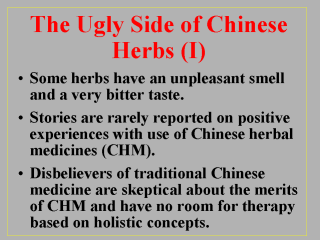| front |1 |2 |3 |4 |5 |6 |7 |8 |9 |10 |11 |12 |13 |14 |15 |16 |17 |18 |19 |20 |21 |22 |23 |review |
 |
In addition to
the generally unpleasant smell and bitter taste, the part that makes many Chinese herbal
medicines (CHM) ugly and unacceptable to a great number of people is these people’s lack
of confidence in the medicinal use and health effects of herbal remedies. Despite the fact
that more and more people begin to accept traditional Chinese medicine (TCM), there are
still many people who are rather skeptical about the merits of TCM in general, and of CHM
in particular. It can be said that TCM was basically a strange health practice to the Westerners until three decades ago in 1972, the year when New York Times editor James Reston underwent an emergency appendectomy during his assignment to China covering President Richard Nixon’s historical trip to that country. The New York reporter experienced a painless recovery in that country through acupuncture treatment and later wrote a series of articles about his positive experience with this ancient needle therapy. However, such stories are never told often enough, or on that order of magnitude. Many disbelievers of TCM already found it inconceivable that a human body is made up of billions and billions of atoms and molecules which cannot be seen with the naked eye. They thus have no room to take up those holistic, complex theories that are so fundamental to TCM. Nor would they accept easily the ‘unscientifically-based’ construct that the five elements Metal, Wood, Water, Fire, and Earth are profoundly interacted or interrelated with one another and with the various human organs’ physiological functions. |